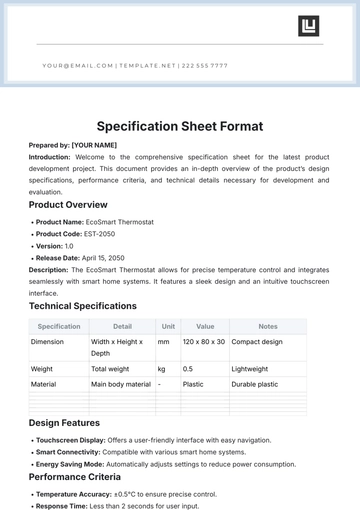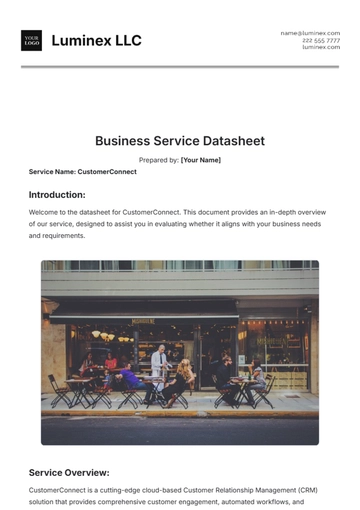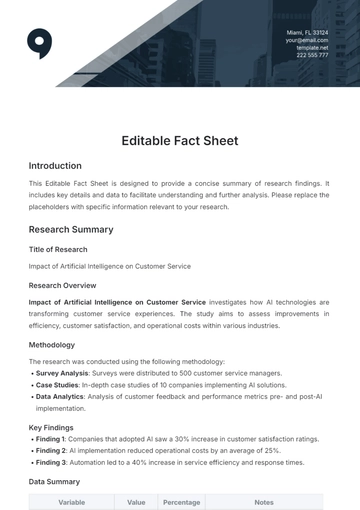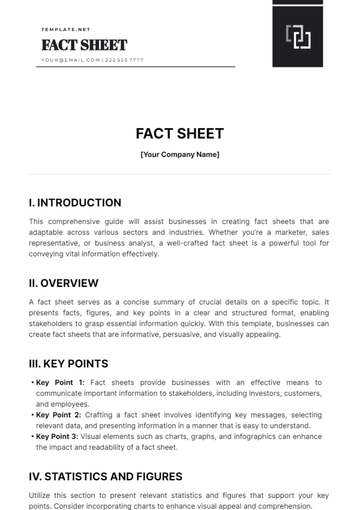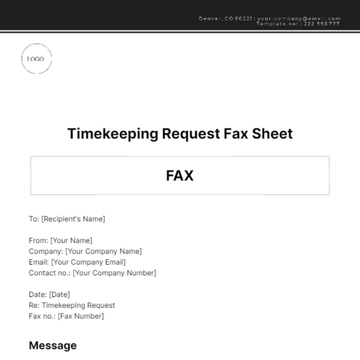Free Fact Sheet
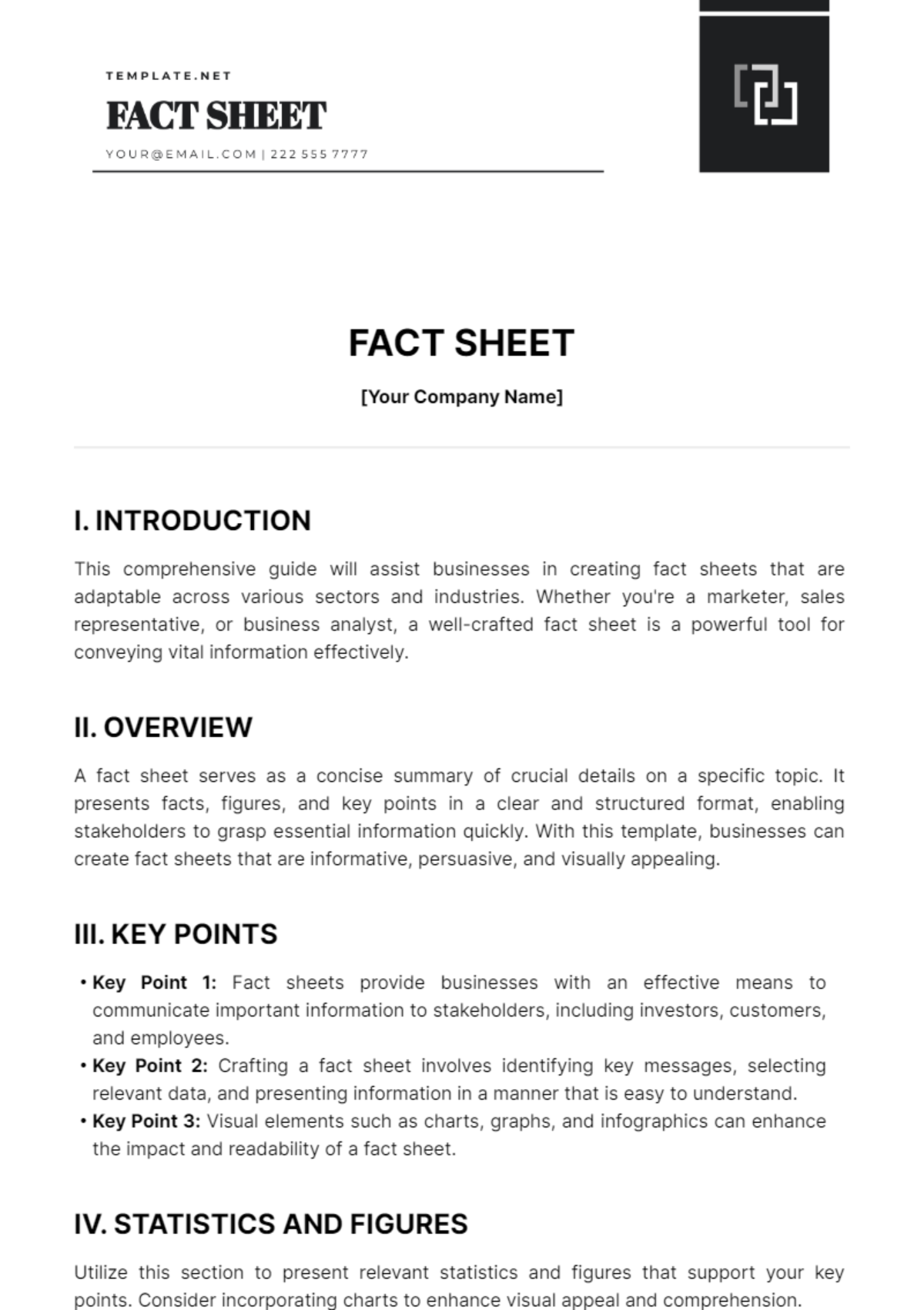
[Your Company Name]
I. INTRODUCTION
This comprehensive guide will assist businesses in creating fact sheets that are adaptable across various sectors and industries. Whether you're a marketer, sales representative, or business analyst, a well-crafted fact sheet is a powerful tool for conveying vital information effectively.
II. OVERVIEW
A fact sheet serves as a concise summary of crucial details on a specific topic. It presents facts, figures, and key points in a clear and structured format, enabling stakeholders to grasp essential information quickly. With this template, businesses can create fact sheets that are informative, persuasive, and visually appealing.
III. KEY POINTS
Key Point 1: Fact sheets provide businesses with an effective means to communicate important information to stakeholders, including investors, customers, and employees.
Key Point 2: Crafting a fact sheet involves identifying key messages, selecting relevant data, and presenting information in a manner that is easy to understand.
Key Point 3: Visual elements such as charts, graphs, and infographics can enhance the impact and readability of a fact sheet.
IV. STATISTICS AND FIGURES
Utilize this section to present relevant statistics and figures that support your key points. Consider incorporating charts to enhance visual appeal and comprehension.
Statistic/Figure | Description |
|---|---|
$2.3 trillion or 90% | The global market size of the e-commerce industry in 2060. |
87% | Percentage of consumers who consider online reviews before making a purchase. |
42% | Increase in brand awareness observed after distributing fact sheets at industry events. |
V. COMMON MYTHS
Address common misconceptions or myths related to the topic at hand. Dispelling myths can provide clarity and promote informed decision-making among stakeholders.
Myth 1: Fact sheets are only useful for large corporations with extensive marketing budgets.
Myth 2: Fact sheets are overly technical and unsuitable for communicating with non-specialist audiences.
Myth 3: Fact sheets are redundant in the digital age, where information is readily available online.
VI. FAQS
Anticipate and address common questions that businesses may have about creating and using fact sheets. Providing comprehensive answers can facilitate the effective utilization of fact sheets in business communications.
Question 1: How can businesses ensure that their fact sheets stand out from competitors? Answer: By focusing on concise messaging, visual appeal, and providing unique insights or data, businesses can differentiate their fact sheets in a crowded market. |
Question 2: What are some best practices for distributing fact sheets? Answer: Businesses should leverage a multi-channel approach, including email, social media, industry events, and direct mail, to reach their target audience effectively. |
Question 3: How frequently should businesses update their fact sheets? Answer: Fact sheets should be periodically reviewed and updated to ensure that they reflect the latest information and developments relevant to the business and its stakeholders. |
VII. CONCLUSION
In conclusion, a well-crafted fact sheet is an invaluable asset for businesses seeking to communicate key information effectively. By leveraging this and customizing it to suit their specific needs, businesses can create fact sheets that inform, persuade, and engage their target audience, ultimately driving success in their endeavors.
- 100% Customizable, free editor
- Access 1 Million+ Templates, photo’s & graphics
- Download or share as a template
- Click and replace photos, graphics, text, backgrounds
- Resize, crop, AI write & more
- Access advanced editor
Enhance and Discover the Fact Sheet Template from Template.net. Crafted for convenience, this editable and customizable tool empowers users to create polished fact sheets effortlessly. Tailor content to perfection using our AI Editor Tool. Elevate your presentations with professional precision. Simplify your workflow with Template.net's Fact Sheet Template today.
You may also like
- Attendance Sheet
- Work Sheet
- Sheet Cost
- Expense Sheet
- Tracker Sheet
- Student Sheet
- Tracking Sheet
- Blank Sheet
- Information Sheet
- Sales Sheet
- Record Sheet
- Price Sheet
- Plan Sheet
- Score Sheet
- Estimate Sheet
- Evaluation Sheet
- Checklist Sheet
- Bid Sheet
- Call Log Sheet
- Bill Sheet
- Assessment Sheet
- Task Sheet
- School Sheet
- Work From Home Sheet
- Summary Sheet
- Construction Sheet
- Cover Sheet
- Debt Spreadsheet
- Debt Sheet
- Client Information Sheet
- University Sheet
- Freelancer Sheet
- Bookkeeping Sheet
- Itinerary Spreadsheet
- Scorecard Sheet
- Run Sheet
- Monthly Timesheet
- Event Sheet
- Advertising Agency Sheet
- Missing Numbers Worksheet
- Training Sheet
- Production Sheet
- Mortgage Sheet
- Answer Sheet
- Excel Sheet

